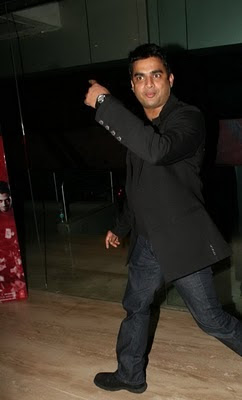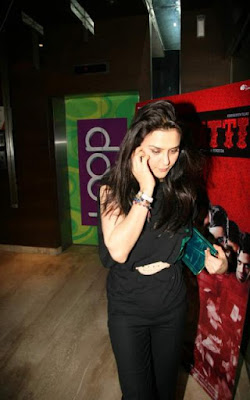Zarine Khan Walks the Ramp for Archana Kochar
Designer Archana Kochhar’s name has always been synonymous with sexy styling; everything was high volume from her bold colour scheme to the use of bright gold embellishments. Archana was making no apologies for the fact that she loves glamour.
Bollywood Actress Zarine Khan stated, “Archana stands for the true essence that, luxury lies in celebrating the Indian wedding. I like to the way she uses colours and jeweled embroideries to add that extra elegance and opulence to her bridal designs. It was a pleasure being associated with her”
Adding to that, Fashion Designer Archana Kochhar stated, “The textile and apparel industry in Gujarat has made rapid advancements over the years. Vibrant Gujarat is a step to raise the levels of branded designs in the Silky City of Diamonds and create a distinguished mark in the fashion industry. This collection resonates bridal opulence and sheer grandeur of the Indian DNA.”
Zarine Khan spells magic as Designer Archana Kochhar's showstopper

Saturday, February 27, 2010
Sayali Bhagat Shoots For The Man Magazine - sexy video showing her behind scenes and make up
Hot Mallika Sherawat Videos From Murder Hot Scenes
Katrina Kaif Bikini Images
Deepika Padukone Photos And Videos
Hot And Sizzingly Tanushree Dutta Exposing Photos
For Gossips And Mirch Masala Log On To Bollywood Paradize
Labels: Hot Pictures, Sayali Bhagat, Videos
Zarine Khan Launches a New Variety of her Festive Collection - Photos
0 comments Posted by org at 7:21 AMHot Mallika Sherawat Videos From Murder Hot Scenes
Katrina Kaif Bikini Images
Deepika Padukone Photos And Videos
Hot And Sizzingly Tanushree Dutta Exposing Photos
For Gossips And Mirch Masala Log On To Bollywood Paradize
Labels: Events, Hrithik Roshan
Shraddha Kapoor, Suzanne Roshan, Preity Zinta at Teen Patti Movie Premiere - Photos
0 comments Posted by org at 7:13 AMShraddha Kapoor, Suzanne Roshan, R Madhavan, Preity Zinta at Teen Patti Movie Premiere

















Hot Mallika Sherawat Videos From Murder Hot Scenes
Katrina Kaif Bikini Images
Deepika Padukone Photos And Videos
Hot And Sizzingly Tanushree Dutta Exposing Photos
For Gossips And Mirch Masala Log On To Bollywood Paradize
Labels: Events, Teen Patti
Aishwarya Rai, Jaya Bachchan & Amitabh Bachchan in Bhavnagar - Photos
0 comments Posted by org at 7:11 AMThe Bachchans are in Bhavnagar to attend Shri Prithvirajsinh’s uttarkriya ceremony at Dared. Late Prithvirajsingh was Amar Singh's brother in law.

Hot Mallika Sherawat Videos From Murder Hot Scenes
Katrina Kaif Bikini Images
Deepika Padukone Photos And Videos
Hot And Sizzingly Tanushree Dutta Exposing Photos
For Gossips And Mirch Masala Log On To Bollywood Paradize
Labels: Aishwarya Rai, Amitab Bachan
Friday, February 26, 2010
Asin, Genelia D'souza, Sherlyn Chopra at Filmfare Nominations 2009 Red Carpet - Photos
0 comments Posted by org at 10:06 AMHot Mallika Sherawat Videos From Murder Hot Scenes
Katrina Kaif Bikini Images
Deepika Padukone Photos And Videos
Hot And Sizzingly Tanushree Dutta Exposing Photos
hot sexy unseen pics of genelia d zousa looking sexy in short dress
For Gossips And Mirch Masala Log On To Bollywood Paradize
Labels: Asin, Events, Genelia D Souza, Hot Pictures, Sherlyn Chopra
 My oldest daughter will be 10 years old tomorrow (omg...that's the double digits as she likes to say) and it's given me time to reflect about our journey with nut allergies up till now.
My oldest daughter will be 10 years old tomorrow (omg...that's the double digits as she likes to say) and it's given me time to reflect about our journey with nut allergies up till now.
I know that I've discussed our big and small triumphs here in the past (most recently with my post "Thriving with a Nut Allergy"). However, something about this "double digit" birthday makes me really grateful for how far we've come since our family first learned of Alex's life-threatening allergy to nuts.
A lot of you are reading this blog because you've recently discovered your own child's allergy. I find out when my child was 4 years old and I know that many of you learned sooner. When you first get this diagnosis, it's so scary and can seem really disheartening once you realize how much it affects daily life. I still have my good days and bad days.
However, as my daughter reaches her 10th birthday, I'm very proud of how much she's been able to do and how confident she has become about handling her allergy issues.
For those of you new to this, here is some of my advice, some of it learned the hard way. :)
- Never let your child feel like they can't do something just because of their allergy. In fact, we've sometimes given our daughter a gentle nudge out into the world to prove that she can handle certain situations. Now that she's older, she initiates independence. That's really important to us since she is the one who will be caring for her allergy in the future.
- Be cautious, but keep things as normal as possible. Caution is key but so is a normal childhood in terms of things like birthday parties, camp and extracurricular activities. If you take all the proper precautions things will generally go well. Volunteering to help out at these activities when your kids are younger will help both of you feel more secure. Most important, don't focus too much on your child being the "allergy kid" beyond making certain an activity is safe for them.
- On the other hand, don't beat yourself up for the things you can't do. Trying every new restaurant is just not on our family agenda; likewise, sleepovers are off-limits except for very close friends of the family who we trust. Some things just aren't worth it and we stick to firm rules about them. Instead of focusing on what we can't do safely, we celebrate the things that we can.
- Realize that as your child gets older, your role as a parent must adapt to their growing independence. My daughter often reminds me these days that she knows what to do about her allergy and not too hover over her too much. In fact, there have been several situations where she exercised caution all on her own. She's still too young to be completely free of parental involvement, but I try to show her that I trust her to handle things when appropriate. It's been a real confidence-booster for her as well as a lesson in taking charge of her own allergy.
Now the flip side: Vigilance around high-risk foods can never let up. Until there is a cure for nut allergies, the risk of reaction must never be discounted. Sometimes we let our guard down if we've gone a long time without a reaction. This is a mistake--you can never plan when a reaction will occur. Stay vigilant with regard to foods and situations and keep teaching your child to stay vigilant while still encouraging their independence.
Just so everyone knows, I'm hosting next week's "Living with Food Allergies Blog Carnival" so if you're an allergy blogger, please submit an article. I need them in by March 3rd (next Wednesday). Thanks!
Wednesday, February 24, 2010
Monday, February 22, 2010
The information I'm about to share is not to scare anyone away from dining out, but I think it points to the awareness we need to have at all times. It's not only about what food is offered at a restaurant or establishment and not only how the food is prepared. You've also got to ask yourself--WHO is handling the food.
Here's what my husband and I observed at a bagel shop on Sunday morning. (This was without the kiddos; they were with their aunt.)
While in downtown Chicago at a national bagel chain, my husband noticed a shop employee taking a jar of peanut butter out of her bag and preparing an elaborate peanut butter-centric meal involving all manners of fruits, breads and PB. LOTS of PB--she brought her own jar, for goodness sakes! This was being eaten in the customer area (so if anyone hasn't bought into the idea of putting down a "place mat" on the table when you dine out with your allergic child please reconsider--you never know who was eating what before you sat down.)
The actions of this restaurant employee raised all sorts of red flags to me because what happened after the employee had eaten her meal? Was she going to carefully wash off every trace of peanut butter before serving customers? Did she know she was potentially setting up a scenario for cross-contact that could adversely affect consumers? So far, Massachusetts is the only state requiring food allergy education for restaurant workers. Obviously, this education is needed everywhere--not just one state.
The other thing this incident points to is that while a restaurant or fast food joint may not have peanut butter on the menu, who knows what is going on behind the scenes? Even if you haven't seen one too many episodes of "Ramsey's Kitchen Nightmares" like I have, this is something to think about. It just proves that you want to stick to the cleanest, most professional, most hygienic places you can. That's not bad advice for anyone dining out but for food-allergic people it's a must.
The bagel shop we were eating at does offer PB as a topping for the bagels, and some of the bagels occasionally have nuts on them. I would probably not take my daughter there since I categorize a bagel shop as a small bakery and therefore, off limits.
But it sure got me thinking about the places we go and who is making the food. I always ask myself a few questions before dining out:
- First and foremost, does the place serve peanut butter food items? If so, do they prepare them in a confined area? Are the staff aware of the cross-contact dangers? Ask. Their answers will tell you a lot about whether or not you want to eat there. Pot Belly Sandwich Works does a good job of segregating peanut butter from the other ingredients but still, human error is always a factor.
- Who is working there? Is it staffed by young college students who may or may not be strict professionals about food service? Are they eating on the job?
- Have you done your homework about a place or are you just stopping in? If possible, stick to places where you know the menu and the general approach to food service. If this is not possible, don't settle if you think the place doesn't "get" food allergies. Better safe than sorry. And luckily, many places do get it now. Still, staying vigilant is always best.
I'm sure this bagel shop worker was a nice person who just wanted a quick snack on her break, but when she opened that jar of peanut butter she opened a can of worms. I'm going to shoot an e-mail to the manager of the store to let him or her know what I observed. And I definitely won't be taking my daughter to there.
Friday, February 19, 2010
 My youngest daughter's 7th birthday is today and besides the fact that I'm astounded at the fact that my "baby" is almost a second-grader, it got me thinking about our school's treat policy.
My youngest daughter's 7th birthday is today and besides the fact that I'm astounded at the fact that my "baby" is almost a second-grader, it got me thinking about our school's treat policy.
I'm happy to say that our current elementary school does not allow treats of any kind for birthdays or holidays. Non-edible or edible, they're not allowed, period.
This was a hard-won policy. According to other mothers I know whose kids have food allergies, there was a lot of bickering about treats not being allowed. The kids with food allergies were blamed, apparently. (We were not yet part of this school when the policy first went into place.)
However, food allergies were only part of the reason for banning treats. Many other factors went into the decision and I heartily applaud our current school principal for standing up to the cupcakers on this one.
There are so many reasons why a school may choose to avoid exchanging treats and here are some of them:
1) Too many sweets equals overweight kids with bad teeth. The school is trying to teach good health practices.
2) Dietary restrictions are becoming more common, not just due to food allergies but due to juvenile diabetes.
3) Sugar high = classroom mayhem.
4) Respect for socioeconomic differences - not everyone can afford a treat for the class.
5) The kids already have their birthdays celebrated at school in many ways. They get an announcement over the loudspeaker, they get a free book from the PTO and the whole class sings happy birthday. Enough already!
6) Passing out treats eats up valuable class learning time.
7) We're at a public school and not everyone is celebrating the same holidays.
Besides being thrilled that my allergic daughter is not constantly being given possibly unsafe treats during the school day, I've gotta just say: it takes the pressure off when you aren't expected to whip up a little personalized goody bag for the whole class. I love my kids as much as the next person but when I'm already planning extracurricular celebrations for them, I really don't want to be bested by somebody with a label-maker and a flair for crafts.
Have you guys ever seen that accusing look from your kids when they come home with a really spectacular goody bag? I'll bake from scratch for my kids all day long but I'm just not a creative goody bag kinda gal.
Now, many of you out there still deal with classroom treats all year (and our family did as well, at a previous school) and there are ways to combat it, many of which I've discussed on this blog. Having a well-stocked supply of safe treats and suggesting non-edibles are two good strategies but treats-free is still a good solution.
What is your school policy and how do you deal with it? I know this is a hot-button issue, so let us know what's going on where you live.
Wednesday, February 17, 2010
I just read this article in Chicago Parent about new research about introducing solid foods in babies. The timing of solids is thought to have an effect on later development of food allergies.
When my kids were babies, we were told to hold off on solid foods until 6 months of age. Now, the new research (discussed in the Chicago Parent article) shows that babies should be given solids at 4 months of age. This is thought to possibly prevent the development of food allergies.
Medical disclaimer alert! Of course, every baby is different, so please always consult your own doctor about the introduction of solids. Thank you. :)
I don't know about many of you, but I had no choice but to give my two kids solids younger than 6 months. Way younger. (I got the OK from the pediatrician, of course.) My babies were huge and they were hungry. Interestingly, one child developed food allergies and one didn't. This new research raises more questions for me, defintely.
The whole idea of babies getting diagnosed with food allergies is very interesting to me because I didn't know about my daughter's nut allergies until she was in preschool. I can imagine how difficult this would be for parents of infants -- what would you do about introducing new foods, for example. And of course, the introduction of babysitters takes on a whole new level of stress.
On a freelance writing note, I'm interested in writing about this issue for a local magazine, so any of you Chicago-area parents who have young babies getting diagnosed with food allergies, please send me an e-mail. I'd love to hear from you if you wouldn't mind sharing some of your experience with me for a future interview. I have a few sources already but I can always use more.
No matter where you live, I'd love to hear about your concerns in caring for food-allergic babies. What support and info do you need? Let us know.
"Anger at the (prison camp) conditions led to (German) prisoners scraping handfuls of lice off their own bodies and throwing them at their (Soviet) guards. Such protests provoked summary execution."
Reviews
Many believe Stalingrad to be the turning point of the war. The Nazi war machine proved to be fallible as it spread itself too thin for a cause that was born more from arrogance than practicality. The Germans never recovered, and its weakened defenses were no match for the Allied invasion of 1944. We know little of what took place in Stalingrad or its overall significance, leading Beevor to humbly admit that "[t]he Battle of Stalingrad remains such an ideologically charged and symbolically important subject that the last word will not be heard for many years." This is true. But this gripping account should become the standard work against which all others should measure themselves.
Saturday, 21 June 1941, produced a perfect summer’s morning. Many Berliners took the train out to Potsdam to spend the day in the park of Sans Souci. Others went swimming from the beaches on the Wannsee or the Nikolassee....In the Soviet Embassy...an urgent signal from Moscow demanded "an important clarification" of the huge military preparations along the frontiers from the Baltic to the Black Sea.
British historian Antony Beevor begins his narrative quietly, steadily, uneasily. Moving briskly between rapidly intensifying German and Russian scenes, Beevor provides some of the historical context for the events leading toward the terrible battle of Stalingrad.
GREAT WAR BOOKS: D-DAY: The Battle for Normandy by ANTONY BEEVOR
0 comments Posted by org at 4:45 AMAt one point, during the fierce battle for the town of Saint-Lô, Beevor quotes a medic: "It's such a paradox, this war, which produces the worst in man, and also raises him to the summits of self-sacrifice, self-denial and altruism." Two pages later he quotes a French gendarme appalled by looting by soldiers and civilians alike: "It was a great surprise to find it in all classes of society. The war has awakened atavistic instincts and transformed a number of law-abiding individuals into delinquents."
Mr Beevor said: “The fighting was indeed ferocious, far more than has been recognised, and that was one of the main themes of my book.
“But many of its battalions were badly shaken, and it took several weeks and a new commander, before its fighting spirit was restored.
“The 51st Highland Division went through a bad patch, but its morale and fighting ability was rapidly restored in late July as I emphasise in my book.”
The Storm of War: A New History of the Second World War by ANDREW ROBERTS
0 comments Posted by org at 4:24 AMCLICK TO BUY - The Storm of War: A New History of the Second World War
Andrew Roberts (born on 13 January 1963) is a British historian and journalist.
Gurardian
Roberts indicates how often Hitler would have done better, and even won the war, if he had made different choices. This is not an original thought, nor is it claimed as such. No one in 1940 needed to tell Churchill that the Germans stood a good chance of crushing the United Kingdom. In the long summer of 1941, as the German armies streamed as fast as their tanks could carry them towards the outskirts of Moscow and Leningrad, it was the belief of nearly every Soviet citizen that the USSR was on the brink of complete defeat. Such was Roosevelt's feeling that the Third Reich was about to gain definitive victory in Europe that he twisted arms in the Washington political establishment to send food and armaments to the United Kingdom even before America's entry into the war.
The central character in the book's drama, inevitably, is Hitler. Roberts's suggestion seems to be that he could only have won the war if he had not allowed it to spiral into a global struggle. Hitler missed his chance to knock out the USSR early on and provoked the US into entering the ring on the side of the opposition. He may have won the war if he had kept it as "the First European War"; the gamble that did not pay off was to make it global.
Timesonline
Ferocious measures were used to compel soldiers to go on fighting in hellish battles such as Stalingrad and Kursk. Stalin shot 135,000 of his own troops — the equivalent of 12 divisions — to encourage the others; before execution they were made to undress so that their uniforms could be reissued. To quote General Zhukov, who also wanted to kill the families of soldiers who surrendered: “In the Red Army it takes a very brave man to be a coward.” Yet Hitler was proportionately even more murderous towards his own forces. It was a tribute to the outstanding qualities of the German soldier, Roberts observes, that the Wehrmacht, retreating on two fronts and battered from the air, remained disciplined and efficient almost to the end.
Independent
The Storm of War is, in fact, a seductively easy read. You could open it at any page and it would not fail to draw you in. Stylistically, Roberts has always been very strong, and this book is happily no exception. He segues effortlessly between theatres and events, weaving a complex yet admirably comprehensible tapestry of the conflict. He also has an excellent eye for the ironies and peculiarities that serve to bring his story most vividly to life.
 Platoon is a 1986 epic war film written and directed by Oliver Stone and starring Tom Berenger, Willem Dafoe and Charlie Sheen, with an early appearance of Forest Whitaker and a small supporting turn from Johnny Depp. It is the first of Stone's Vietnam War trilogy, followed by 1989's Born on the Fourth of July and 1993's Heaven and Earth.
Platoon is a 1986 epic war film written and directed by Oliver Stone and starring Tom Berenger, Willem Dafoe and Charlie Sheen, with an early appearance of Forest Whitaker and a small supporting turn from Johnny Depp. It is the first of Stone's Vietnam War trilogy, followed by 1989's Born on the Fourth of July and 1993's Heaven and Earth.
The story is drawn from Stone's experiences as a U.S. infantryman in Vietnam and was written by him upon his return as a counter to the vision of the war portrayed in John Wayne's The Green Berets. The film won the Academy Award for Best Picture of 1986. In 2007, the American Film Institute placed Platoon at #83 in their "100 Years...100 Movies" poll. British television channel Channel 4 voted Platoon as the 6th greatest war film ever made, behind Full Metal Jacket and ahead of A Bridge Too Far.
TRAILER OF PLATOON
STILLS FROM THE FILMS......
Labels: movies, OLIVER STONE, PLATOON










.jpg)
.jpg)
.jpg)
.jpg)









